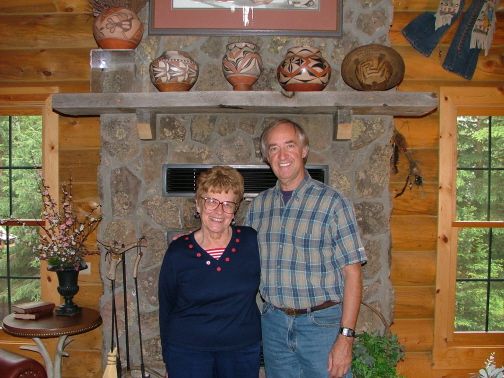
THE MAGICAL HISTORY TOUR
For several years Steve had been pondering the idea of traveling backward through time and geography, retracing the migration route of his branch of the Van Slyke family tree to its roots in what is now New York State. Clearly this would not be a short, week-long, trip. Kay was "thrilled" with the idea of spending a month on the road visiting towns, cemeteries and vacant fields that somehow held significance to her Quixotic husband. Nevertheless, she opted to accompany him rather than let him wind up at the bottom of a ravine in the van somewhere, never to be seen or heard from again.
So it was that we set out in late May of 2007 on what Steve refers to as "The Magical History Tour", stealing a theme from The Beatles. After living on a 41-foot boat for 17 years, we were somewhat prepared for a month in our 19-foot Chevy camper van. But "Quailie" as we call her, has most of the mod-cons that make life comfortable: air conditioning, hot & cold running water, tub & shower, propane furnace, stove and refrigerator, microwave and flat screen TV. So even though it might seem a bit cramped to some, it was not much of a hardship for us.
Half way through the creation of this web page, we opted to excise the parts that had little to do with genealogical quest, and were more in the nature of opportunistic sightseeing. If you're interested in seeing those bits as well--or instead--click here. That said, we now quickly jump from Washington State to western South Dakota.

Our first stop on the history tour was not a planned one. Barb Shilvock, a distant cousin of Steve's who lives in the Black Hills of South Dakota found out about the trip from a message Steve had posted on RootsWeb. Barb invited us for breakfast which dovetailed perfectly with our schedule for visiting Mount Rushmore.
Steve and Barb are connected through David Oyer Van Slyke, Steve's great-great grandfather. We had a great visit with Barb at her beautiful log cabin home in the pine forests of the Black Hills.
Barb had been trying to solve a mystery about a crush that her grandmother had had on a distant cousin from Madison, South Dakota. Her research indicated that the cousin might have been Carroll Van Slyke the half-brother of Steve's grandfather, Claude. But the photo she had obtained was of Claude not Carroll. Fortunately, Steve had a high-school photo of Carroll with him and Barb was able to copy it before we left.
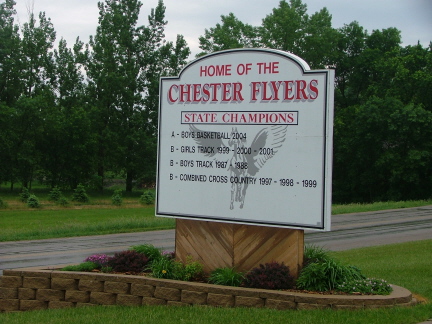
Madison, South Dakota is in the eastern part of the state and it was the next stop on the tour. However, the history of Steve's ancestors in South Dakota actually begins in the extremely small town of Chester not far from Madison.
Steve's great grandfather, Frank Romanzo Van Slyke moved to this area shortly after marrying Adelia Wright in Trempealeau, Wisconsin.
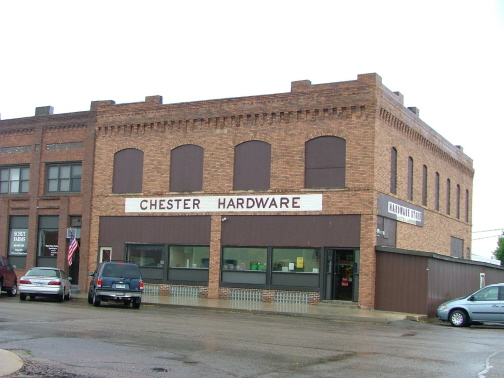
It is unclear how long Frank and Adelia lived in Chester, or even if they had a permanent residence here, but what is clear is that their first child, Emory Claude Van Slyke, Steve's grandfather was born here.
It appears that they soon took up residence in the county seat, Madison, within a short time after Claude was born.
Frank became County Clerk of Lake County, South Dakota and is mentioned in the public record of a murder case in which a bordello madam shot and killed her husband. Apparently, there was more to Madison back then than one might have thought.
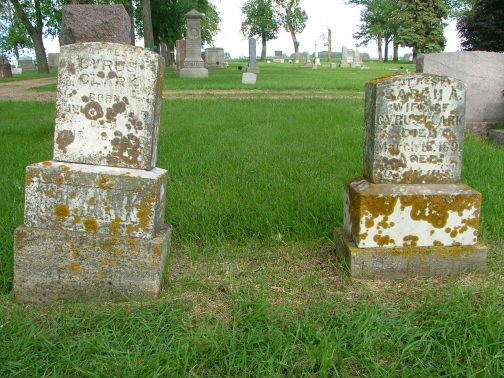
After moving to Madison, Adelia gave birth to her second child, Stella. Unfortunately, Adelia contracted puerperal fever and died when the child was only four months old. The child died just a few days after her mother.
Steve wanted to find Adelia's gravesite and marker. The local historical society records indicated that she was indeed buried in the town cemetery but there was no record of the plot number.
Our search of the entire cemetery failed to locate a marker for Adelia. However, as Steve was checking a row of markers he happened to see the name Clark on a pair of markers. Steve's full name is Steven Clark Van Slyke. Clark was his grandmother's maiden name. A quick check of records in the van confirmed Steve's suspicion. These are the markers of his great-great grandparents, Cyrus and Sarah Clark.
Steve had completely forgotten for the moment that the Clark side of his line was also from Madison, and that it was here that Claude Van Slyke first met his future wife, Minne Alice Clark, Steve's grandmother.
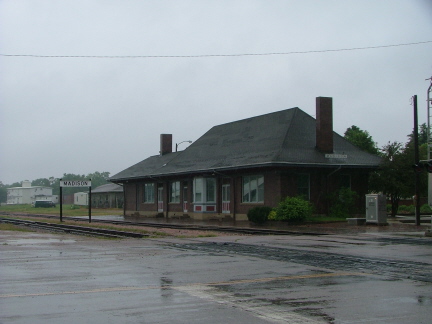
Frank eventually remarried. His second wife, Ida Estella Clark, the daughter of Cyrus and Sarah and sister of the town's physician, Dr. Edwin Lester Clark, father of Minnie Alice. So, it would come to pass, that Claude Van Slyke would eventually marry his step-mother's niece--got that?
Frank, like so many other men of his time, decided to move the family to the Far West. This is the Madison train station today. It appears passenger trains no longer stop here, the station now serving as a museum. But in 1906 the Van Slyke family that now consisted of Frank, Ida, 19-year-old Claude and his younger half-brother Carroll, probably boarded a westbound train here with the ultimate destination of Salem, Oregon, where members of another branch of the family, the Bunns, had already settled.
Minnie Clark, on holiday from nursing school, would one day visit her Aunt Ida in Salem and fall in love with her aunt's then 20-something stepson Claude. Minnie and Claude's son Robert, and their grandson Steve, were both born in Salem.
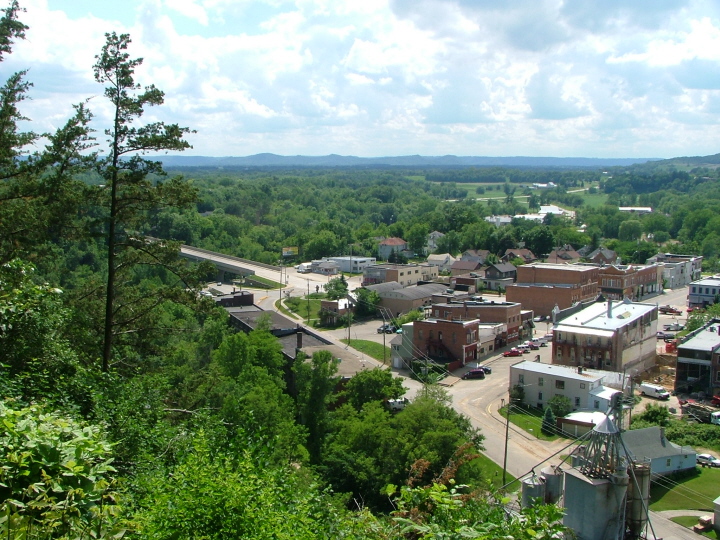
Galesville, Wisconsin is ground zero for the many Van Slykes descended from David Oyer Van Slyke, Steve's great-great grandfather.
If you look closely, at the near end of the bridge leading into Galesville, you might see a statue on a small green knoll. The statue is the same one seen in the photo below, and is none other than "D-O" himself, as he is known to the clan. This photo was taken from the cemetery on the bluff above town where DO is buried.
DO moved his family to Galesville in 1854, first from western New York, and then from Kenosha, Wisconsin.
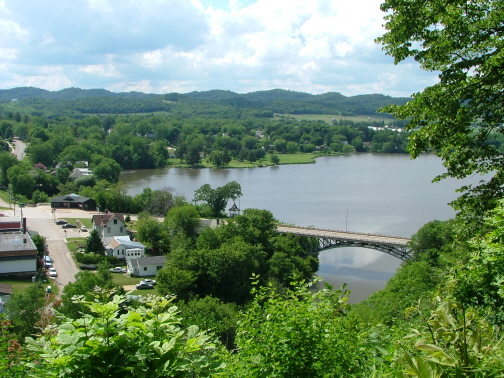
Panning to the right and the other end of Galesville, one sees the lake created by a small mill dam on the back side of town.
One of DO's young sons, George Gale Van Slyke (named for the town's founder) drowned in the mill pond just this side of the bridge in this photo.
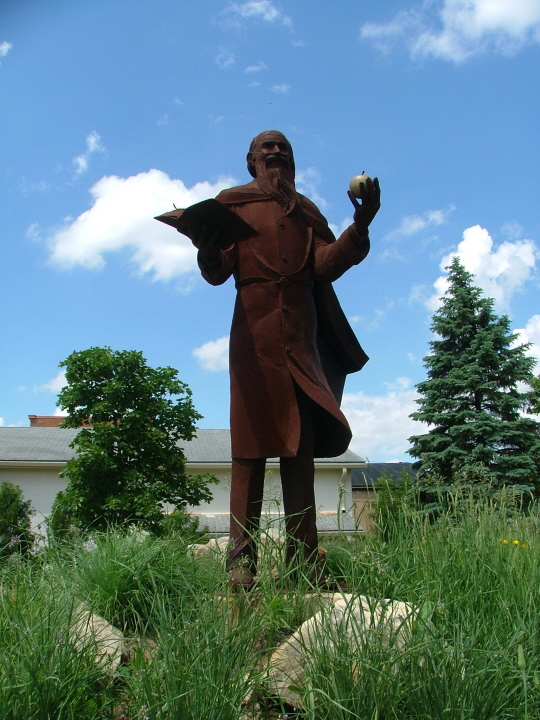
Here is the 9-foot bronze statue of David Oyer Van Slyke, seen in the distance in the first photo of Galesville, above.
Besides being a farmer and having served with the Wisconsin Volunteers of the Union Army during the Civil War, DO was a circuit-riding preacher, without a permanent flock of his own.
According to family history and his own diaries, DO had read the Bible as many as two dozen times from cover to cover. The combination of his travels around the Galesville - Trempealeau area and his bible studies eventually led him to develop the theory that Galesville was in fact at the center of the true, biblical Garden of Eden. So convinced was he that he wrote a booklet documenting all of the geological and geographical facts supporting his theory.
The booklet is still in print to this day and can be purchased in Galesville. The description of Galesville and the surrounding area is so idyllic that any real estate developer today would certainly have hired him to write advertising copy.
It is for his Garden of Eden theory that the good people of Galesville erected this statue of him in 1999.
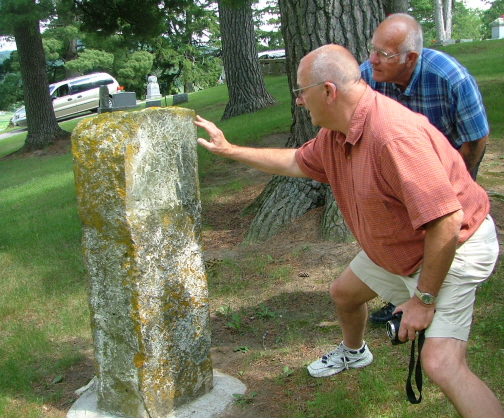
Steve's third-cousins, Miles (closest) and Ralph (first-cousins to each other) inspect DO's grave marker.
DO quarried the large slab of limestone from the Minnesota cliffs on the other side of the nearby Mississippi River.
DO's name is only barely visible due to the erosive effects of acid rain over the years.
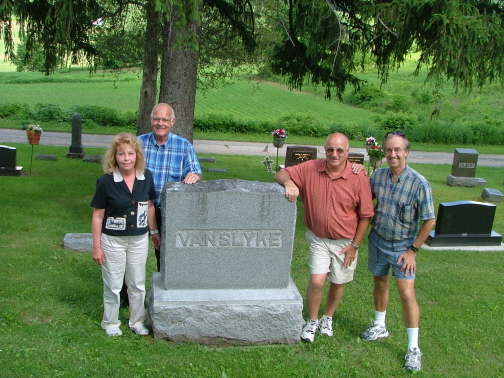 Left to right, Vickie Van Slyke Nichy,
Ralph Van Slyke, Miles Van Slyke and Steve stand next to the
family grave marker of Vickie's great grandfather, Charles Sumner
Van Slyke, brother to Steve's great grandfather Frank Romanzo Van
Slyke, (both were sons of DO). Barb Shilvock in South Dakota is
also connected to us through Charles.
Left to right, Vickie Van Slyke Nichy,
Ralph Van Slyke, Miles Van Slyke and Steve stand next to the
family grave marker of Vickie's great grandfather, Charles Sumner
Van Slyke, brother to Steve's great grandfather Frank Romanzo Van
Slyke, (both were sons of DO). Barb Shilvock in South Dakota is
also connected to us through Charles.
This is in the same Galesville cemetery where DO is buried, but just a little farther back from the edge of the bluff and a bit downhill.
Vickie now lives in Kenosha, Wisconsin, Ralph in Lodi, Wisconsin, and Miles in Mosinee, Wisconsin. They were all kind enough to drive to Galesville to rendezvous with Steve for a mini-reunion.
Although I have no documentation to support it, I am fairly certain that Charles Sumner Van Slyke was named for Charles Sumner, a United States Senator and perhaps the pre-eminent voice of the anti-slavery movement at the time of Charles' birth in 1854. DO was himself so opposed to slavery that he enlisted in the Union forces at the age of 44 when the Civil War broke out.
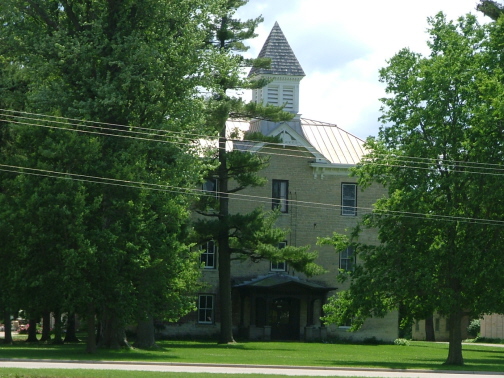
DO and town founder George Gale, among others, contributed land to build one of the first college's in Wisconsin, this being Galesville College.
DO's son Frank, Steve's great grandfather, was one of its earliest attendees. Frank also attended the business college in nearby La Cross, Wisconsin.
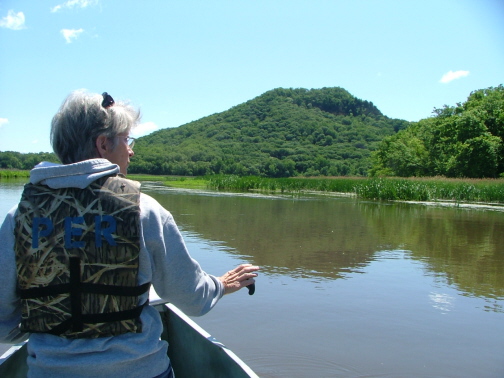
We spent three days in the Galesville area, however we actually stayed in a state park near the town of Trempealeau, which is right on the Mississipi river, just a few miles from Galesville.
Trempealeau is where Steve's great grandfather, Frank, met and married Adelia Wright. And it is believed that it was a hill like the one in the distance in this photo, that DO climbed and surveyed the surrounding area and developed his Garden of Eden theory as he noted the confluence of the three major rivers in the area, matching the desciption of the Garden in the Bible.
We spent the morning of our last day in the area, paddling a canoe around a large, looping slough of the Mississippi that backs into farmland near Trempealeau.
This is truly a beautiful area, worthy of a visit regardless of family history.
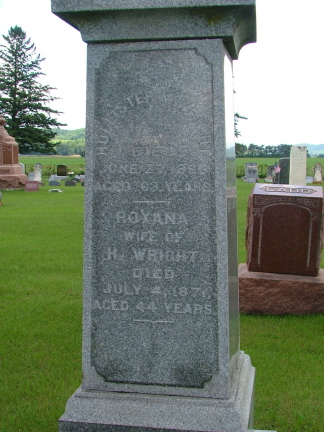
Not far from Trempealeau, and near an area known as Wright's Corners we found Evergreen Cemetery where we were originally looking for the gravesite and marker for Polly Bunn, mother of DO's wife, Ann Eliza Bunn.
Although we had failed in Madison, South Dakota to find a marker for Adelia Wright, we did manage to find her parents' marker here in the same cemetery with that of Polly Bunn.
It is somewhat hard to read in the photo, but it is the combined marker for Hollister and Roxana Boynton Wright, parents of Adelia Wright Van Slyke (first wife of Frank) and Steve's great-great grandparents.
There are still many of Hollister and Roxana's descendants living in the area. In fact we stopped at a garage sale at a nearby farm owned by a family of Wrights. However, they were unfamiliar with the history of Hollister and Roxana.
Hollister was one of the earliest settlers on Trempealeau Prairie, arriving a year ahead of DO in 1853.
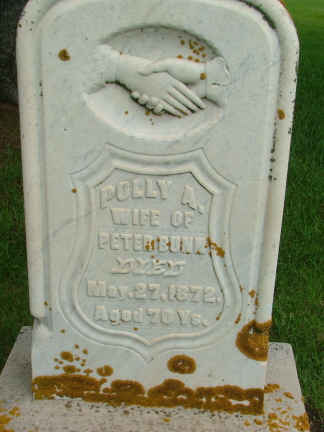
Polly Bunn, mother of Ann Eliza Bunn, DO Van Slyke's wife, moved to the Trempealeau area after her husband, Peter, died in western New York state. Her son Romanzo Bunn helped her move and located in the area himself.
Romanzo went on to become a lawyer, District Attorney for Trempealeau County and eventually a well-known and respected district judge in the state capital at Madison. Steve's great grandfather, Frank Romanzo Van Slyke, is named after him.
This is a fine example of some of the lovely and well-preserved markers of the time, although some orange fungus has taken a liking to it in recent years.
Another marker that we were unable to find was that of Polly's daughter, and DO's wife, Ann Eliza Bunn. We have a copy of her obituary and believe she is also buried in the cemetery on the bluff above Galesville, probably near DO, but as yet we have not located her marker.
Upon leaving Trempealeau, our next destination on the tour was western New York, and so we moved relatively quickly through Wisconsin, Illinois, Indiana, Michigan, Ohio and Pennsylvania.
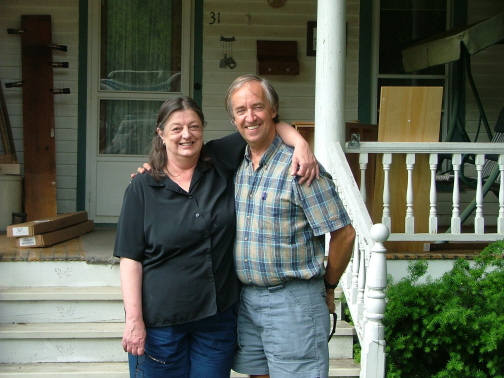
Western New York is a beautiful place in the Spring, and historic Salamanca, New York it a pretty town, much of it built on land that is still part of Seneca tribal land.
It was here that Steve rendezvoused with his distant cousin, Catherine Benjamin. Catherine is a descendant of Andrew Van Slyke, a brother of David O. Van Slyke.
Catherine is a serious genealogist of the family and has managed to piece together the most probable linkage of our Van Slyke branch to the first Van Slyke to immigrate to North America, Cornelis Antonissen Van Slyke, who came over from Bruekelen, Holland in 1634..
She was able to locate a notarized affadavit for a survivor's pension submitted by Augustus Van Slyke, father of Andrew and DO. In the document, Augustus documents certain facts about his father, Martin, who fought in the Revolutionary War. From this and several other sources, Catherine was able to establish a tenuous but highly probable and logical line from Augustus to Cornelis.
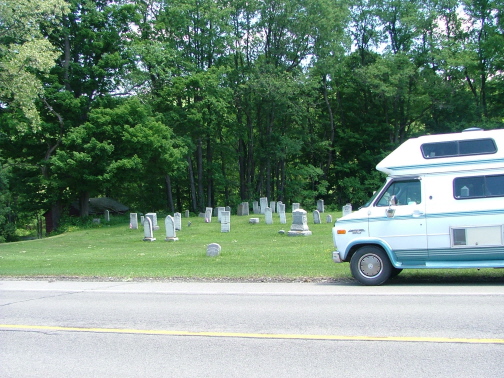
We drove north from Salamanca, to the small village of what today is known as Ashford Hollow and found the marker of Augustus Van Slyke and his wife Nancy.
Back when Augustus first located here, the village was simply known as Ashford. But since there is now also an Ashford Junction nearby, we suppose the "Hollow" was added to help distinguish between the two.
There is no sign at the cemetery and if it hadn't been for Catherine's directions and a copy of her map of cemeteries in the area, I'm sure we never would have found it.
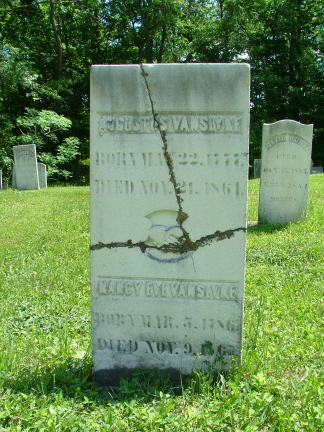
At some point, the marker for Augustus and his wife, Nancy Eve Frank Van Slyke, was apparently vandalized, but then subsequently reassembled by some kind caretaker or perhaps, volunteer. If that person ever happens to chance upon this website, we Van Slyke descendants extend our sincere thanks and appreciation.
Nancy's family, the Franks, are still a well-known and well-represented family in Cattaraugus County, New York. Further north from Ashford Hollow, is the village of Franktown.
The Franks and Van Slykes, along with another family, the Oyers, all moved to Cattaraugus County about the same time, and from the same area near Herkimer, New York.
It is unclear whether their son David (Steve's GGF) was born in Herkimer or Ashford, but there is little doubt that he spent his formative years in this area, and eventually met his future wife, Ann Eliza Bunn here as well. David Oyer Van Slyke, is named for his mother's brother-in-law, David Oyer.
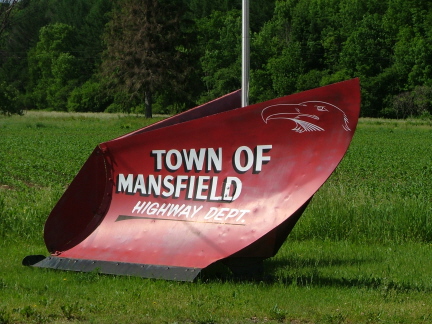
Thanks to a clue in family records passed down to Steve, it seemed that DO's wife, Ann Eliza Bunn, might have come from a town called Mansfield, New York.
Steve was unable to find any such "town" on the map. Catherine Benjamin once again came to the rescue and explained that Mansfield was not a town per se, but a township.
Records indicated that Ann Eliza's father, Peter, and husband of Polly (who's gravesite we noted above in Wisconsin), might be buried somewhere in the township.
It's a short distance nowadays from Ashford to Mansfield township, and the small hamlet of Maples.
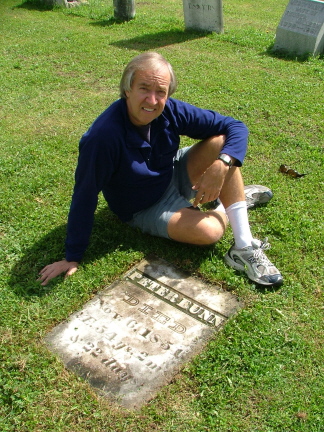
We easily found the well-cared-for Maples Cemetery, with a large and freshly painted sign near the road. We began to develop an unexpected appreciation for the volunteers and caretakers that continue to maintain these old cemeteries that have been full for some time.
Kay quickly found the marker of Peter Bunn, Steve's great-great-great grandfather, father-in-law of DO, father of Ann Eliza. Unlike most of Steve's ancestors, Peter appears to have died at a relatively young age, not long after his parents passed away.
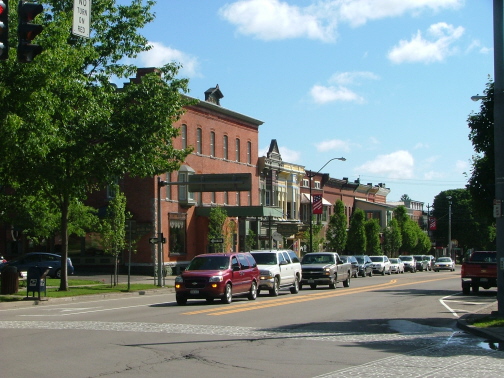
In order to get to either Maples or Ashford Hollow, you first pass through the town of Ellicottville, New York. Today, Ellicottville, is a mini-Aspen, catering to skiiers in the winter and antique shoppers in the summer.
Back in DO's time, Ellicottville, would have been the nearest "big town" and probably the location of the nearest doctor and Justice of the Peace. It is also easy to imagine that it is where people came from the smaller surrounding villages to attend church and Sunday socials.
So, it is likely that it was in Ellicottville, that David Van Slyke of Ashford, met Ann Eliza Bunn of Maples, for the first time.
Coincidentally it is the birthplace of Steve's great grandfather, Frank. Most of David and Ann's children were born in Wisconsin. But it seems Frank was born here when DO and Ann Eliza temporarily moved the family back when they received word that Peter's health was failing. Soon after he died, they returned to Wisconsin and Polly, Peter's widow, soon followed.
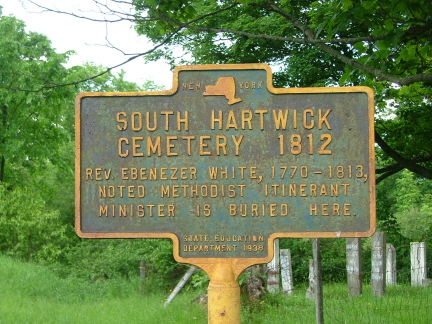
Successfully locating the marker of Peter Bunn in Maples gave Steve the impetus to see if he could go back one more generation in the Bunn line. Family records indicated that Peter and Polly came from a village in Otsego County, New York called South Hartwick.
We could find no South Hartwick on the map in Otsego County, but there was a Hartwick, and it was enticingly close to Cooperstown, New York, which would provide us with the option of a side-trip to the Baseball Hall of Fame.
After finding Cooperstown, we also found Hartwick, but the first one or two people we asked had not heard of South Hartwick. Using scientific logic we drove south from Hartwick. We soon came to a likely looking interesection and stopped at a nearby farm and asked the family that lived there if they knew of South Hartwick and they said "this is it". They also gave us directions to three nearby cemeteries. As it turned out we hit "paydirt" at the first one.
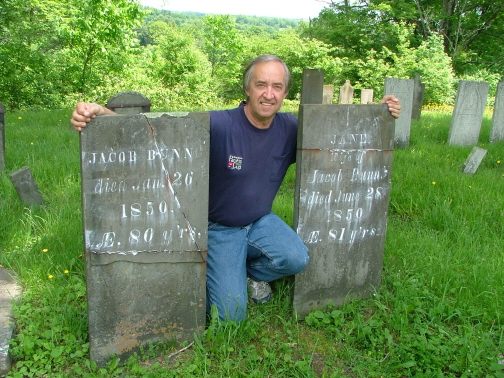
Despite the formal sign and historical marker in the above photo, this tiny cemetery was not nearly so well maintained as others we had seen. Steve was astounded when Kay (again) found the markers of Peter's parents, Jacob and Jane Bunn, Steve's great-great-great-great grandparents.
Somewhere along the way, someone told us the trick of using shaving cream to bring out the details of old, hard-to-read grave markers. As you can see in this photo, it works. All you do is slather on the shaving cream and then scrape away the excess. And of course, it all disappears with the first rain if not sooner.
We had gotten off the Interstate highway to get here and we were enjoying the country roads so much we stayed on them the rest of the way to the eastern-most stop on the Magical History Tour, Schenectady, New York.
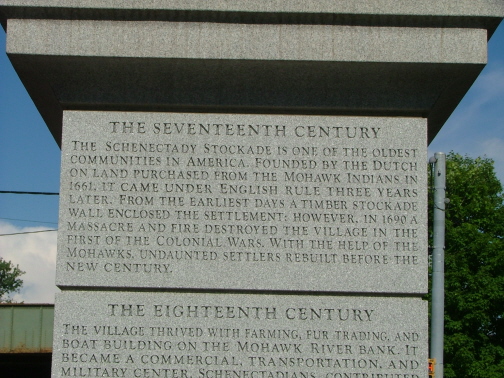
Steve's earliest ancestor in North America, Cornelis Van Slyke, came over from Holland in 1634 to the ten-year-old colony of New Amsterdam (now Manhattan), and made his way up the Hudson River, to Albany.
Cornelis ventured further, up the Mohawk River, to an Indian village called Canajoharie. Here he met a Mohawk girl named Ots-toch, whose biological father appears to have been a well-known Frenchman named Jaques Hertel. Hertel had come as a boy to what is now Canada to live in an Indian village, learn the languages, and become an interpreter for the French fur traders. Cornelis and Ots-toch were married in an Mohawk ceremony, and thus began the Van Slyke line in North America.
Cornelis spent several years traveling up and down the Mohawk River, trading with the Mohawks and sometimes living with his wife in their village. In 1661 he joined 14 other Dutch settlers to build a town surrounded by a stockade on the banks of the Mohawk downriver from Canajojarie. They named it Schenectady.
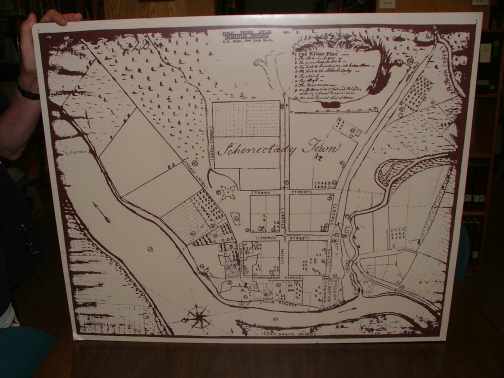
In this old map of Schenectady, the original stockade town was more or less just the four blocks at the bottom center. The main stream of the Mohawk River is on the left. The small stream below the town was called the Binnekill and across that small stream was a large island, of which you can just see the upper edge.
Until relatively recently that island was known as Van Slyck Island. The Mohawks gave the island to Cornelis's oldest son Martin. The official deed is in the photo below.
In recent times the island has been joined to Schenectady and the Binnekill creek routed through a large culvert. Much of the land is still thankfully undeveloped. On the sharp point of land pointing downstream, today there is a small park for launching kayaks, canoes, etc.
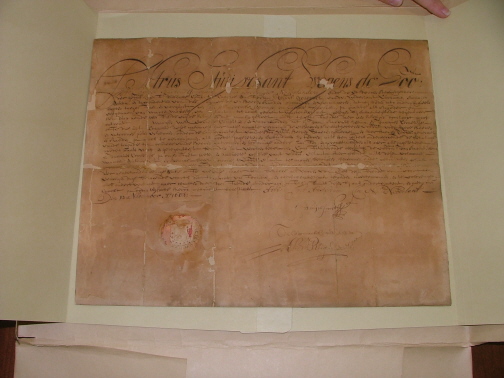
Steve had in his files and old article that claimed that the original deed from Dutch governor Peter (Petrus) Stuyvesant for Van Slyck Island was hanging on the wall of the office the president of Union College in Schenectady.
We went there and spoke with the President's secretary. She said no such document was currently in the office but that we might check the Special Holdings department of Schaeffer Libary on campus.
As soon as we described the document to the two ladies at Special Holdings, one of them immediately thought she knew what it was, and more importantly, where it was. After a short wait, she brought it out for us to carefully view and photograph.
Even though it is written in Dutch, it was amazing to look at a deed to land in what would soon become New York, that was written in 1661, more than 100 years before more famous documents such as the US Declaration of Independance. And it is signed by Stuyvesant, the last and most famous of the Dutch colonial governors.
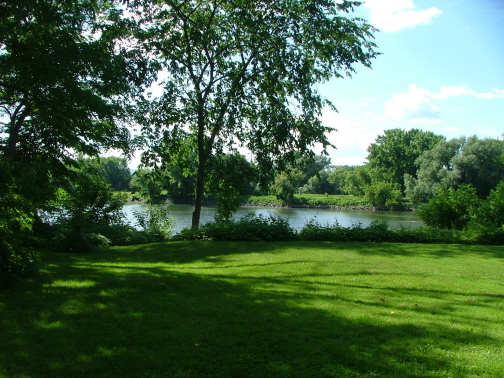
Cornelis' second oldest son Jaques inherited his brother Martin's share of Van Slyck Island. He also owned this piece of land in Schenectady directly across the Binnekill from the point of the island that points downstream. From this view you are looking across the Mohawk River with the Binnekill and Van Slyck Island barely out of sight to the left.
Jaques, like his brothers and sisters, spent their childhood in the Mohawk village of Canajoharie. Most, but not all, eventually moved to Schenectady after it was built. Jaques made his living from a variety of endeavours: farming his lands, trading for furs with the Indians, and acting as an interpreter on behalf of other traders as well as the Dutch and English governments. He also owned the first tavern in town, serving the townspeople and the military force that protected them.
Based on Catherine Benjamin's research and Steve's own analysis, he believes he is a descendant of Jaques.
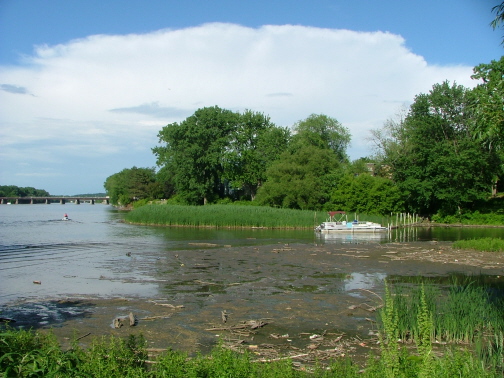
This is almost the opposite view from the above photo, that is, it is taken from the tip of Van Slyck Island looking across the Binnekill on the right and the Mohawk River on the left, toward Jacques' property (similar to the map perspective above).
Jacques, and the other three or four families that had property fronting the Binnekill, built warehouses for preserving and storing the furs they traded for until they were ready to be shipped down river and on to the markets in Europe.
The Indian trappers would have landed their canoes on Jacques' property where you now see the small boat landing.
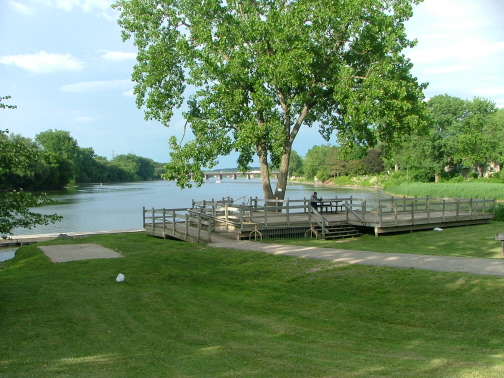
Backing up a bit from the perspective of the above photo, we can now see Gateway Park on the tip of Van Slyck Island.
Sadly, the historic marker in the park fails to mention that the land was once in fact an island named Van Slyck Island and a gift of the Mohawk people to their Van Slyke relatives.
But, on the other hand, we can at least be thankful that the land has not been converted to a shopping mall or housing development. There are athletic fields and cycling or walking trails on the island now, and otherwise it remains in a relatively natural state.
Perhaps if the Van Slykes of North America banded together, and pledged their financial and emotional support, another historical marker that told the rest of the island's story might be added.
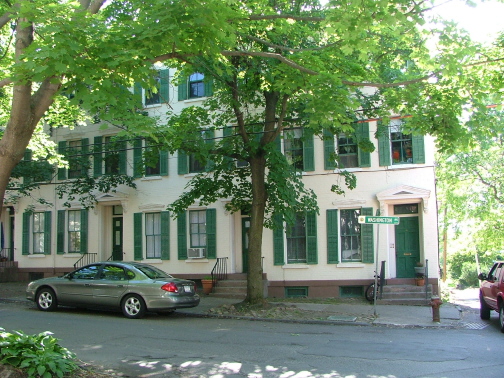
This vintage apartment building sits on the corner of Washington Avenue and Cucumber Alley. This was the original location of Jacques Van Slyke's tavern and home.
The Binnekill is straight ahead down Cucumber Alley along side the building.
Just to the left of the base of the street sign you can perhaps see a bronze plaque on the ground. Once again it commemorates something other than the original history of the site.
It was first assumed that Schenectady would be the end of the genealogical, Magical History Tour. But during the course of our travels, as Steve studied the records, it became clear that there ought to be a couple of more stops as we turned and headed back west.
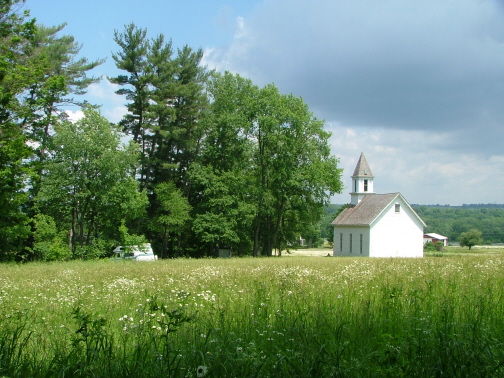
Our return route was north of our eastbound route and took us through other significant locations in the history of Steve's branch of the Van Slykes in North America, such as Fonda, Herkimer, and Frankfort, New York, places where family members had married, lived or been born.
The most important goal for Steve of this final effort was to see if he could find the site of the Mohawk village where Cornelis met Ots-toch, and Jacques and his siblings were raised. We knew the name of the village, Canajoharie, and there is today a town, Canajojarie, New York. But we learned that the Mohawk village of that name was further upriver near the site of a somewhat famous old church .
We found the church easily thanks to a sign on the road that calls it the "Indian Castle Church." Large Mohawk villages were called castles.
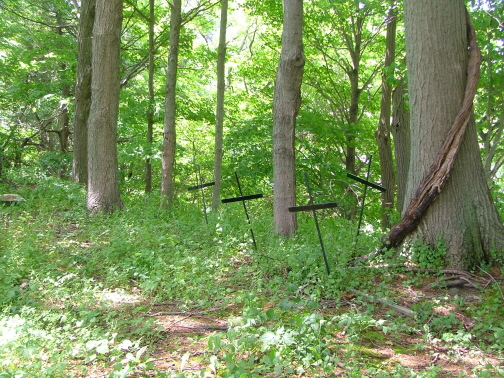
On a slope above the church there's a typical colonial era cemetery with stone markers. But they were all of the same vintage as the church (long after the time of Cornelis and Ots-toch).
A caretaker on a ride-on mower stopped to talk to us when he saw us methodically walking the rows of markers. Steve told him the story of Cornelis and his Mohawk wife, Ots-toch.
The caretaker then pointed back down the hill and said, "If you go out into the trees just in front of where you parked your van (see photo above), you will find some black metal crosses." These, he said, were Indian graves that were opened by an archaeologist a few years earlier for inspection without disturbing the remains. The crosses were put up after the study to mark the graves. We found perhaps two dozen crosses like those in this photo.
It is known that Cornelis Van Slyke died at Canajoharie Castle. Perhaps two of these black crosses mark the burial sites of a Dutchman and his Mohawk wife.
Rather than return home by the same route, we opted to go home via Canada. This ends the genealogical part of our trip. If you're interested in a few photos and comments from our trans-Canada return, please click on this link.
Van Slyke researchers might also wish to visit these websites:
Don Parrish's Hilletie Van Slyck VanOlinda site.
Lorine McGinnis Schulze: The Van Slyke Family in America
Susan J. Staffa: Schenectady Genesis